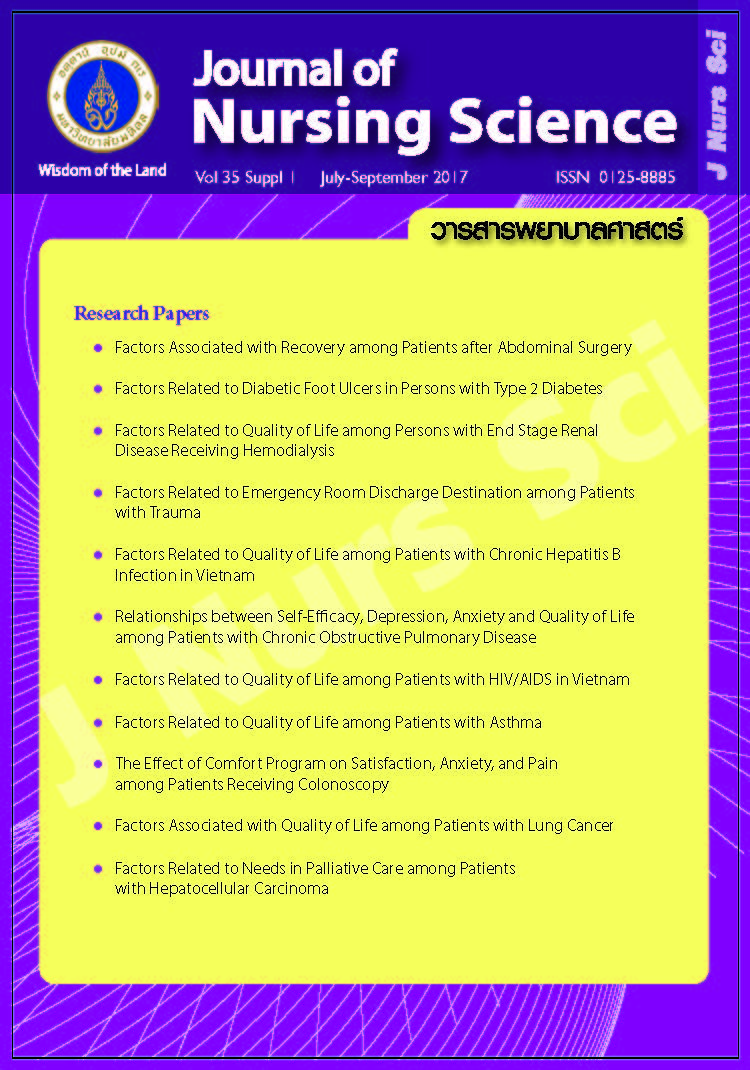Factors Associated with Quality of Life among Patients with Lung Cancer ปัจจัยที่มีความสัมพันธ์กับคุณภาพชีวิตของผู้ป่วยมะเร็งปอด
Main Article Content
บทคัดย่อ
Purpose: To determine factors associated with QOL among patients with lung cancer in Vietnam.
Design: Descriptive correlational design.
Methods: Sample was 115 patients who received treatment at Bac Mai Hospital, Hanoi, Vietnam. Data were collected from the patients’ hospital records, assessed Forced Expiratory Volume in 1 second scale (FEV1), and interviewed with 3 questionnaires: the Hamilton Anxiety Rating Scale (HAM-A), the Multidimensional Scale of Perceived Social Support (MSPSS), and Quality of Life for cancer (EORTC QLQ-C30). Spearman’s Rho was employed to test the relationship among studied variables.
Main findings: The findings revealed that QOL of patients with lung cancer was low (Mean = 48.97, SD = 7.94). Lung function was significant positively correlated with QOL (rs = .190, p < .05). Conversely, anxiety was significant negatively correlated with QOL (r = - .347, p < .05).
Conclusion and recommendations: Lung function and anxiety were significantly correlated with QOL of patients with lung cancer. In order to improve the QOL, nurses and health care team should assess and well manage anxiety and provide social support to patients.
บทคัดย่อ
วัตถุประสงค์: เพื่อศึกษาปัจจัยที่มีความสัมพันธ์กับคุณภาพชีวิตของผู้ป่วยมะเร็งปอด ประเทศเวียดนาม
รูปแบบการวิจัย: วิจัยเชิงสหสัมพันธ์
วิธีดำเนินการวิจัย: ผู้วิจัยเก็บข้อมูลจากผู้ป่วย จำนวน 115 คน ที่มารับการรักษาในโรงพยาบาลแบคมาย เมืองฮานอย ประเทศเวียดนาม เก็บข้อมูลโดยประเมินค่าสมรรถภาพของปอด (FEV1) บันทึกข้อมูลจากแฟ้มประวัติ และใช้แบบสอบถามวัดความวิตกกังวล (HAM-A) การสนับสนุนทางสังคม (MSPSS) และคุณภาพชีวิต (EORTC QLQ-C30) วิเคราะห์ข้อมูลโดยใช้ค่าสถิติ Spearman’s rho
ผลการวิจัย: ผู้ป่วยมีคุณภาพชีวิตอยู่ในระดับต่ำ (Mean = 48.97, SD = 7.94) ค่าสมรรถภาพของปอดมีความสัมพันธ์เชิงบวกกับคุณภาพชีวิต (rs = .190, p < .05) และความวิตกกังวลมีความสัมพันธ์เชิงลบกับคุณภาพชีวิต (r = - .347, p < .05).
สรุปและข้อเสนอแนะ: ค่าสมรรถภาพของปอดและความวิตกกังวลมีความสัมพันธ์เชิงลบกับคุณภาพชีวิต ดังนั้นผู้ป่วยควรได้รับการประเมินและส่งเสริมสมรรถภาพของปอด ตลอดจนการประเมินความวิตกกังวลเป็นระยะช่วงมาตรวจตามนัด และควรพัฒนาโปรแกรมจัดการความวิตกกังวลสำหรับผู้ป่วย เพื่อให้ผู้ป่วยได้รับการดูแลที่ครอบคลุมและมีคุณภาพชีวิตที่ดีขึ้น
Article Details
ลิขสิทธิ์: วารสารพยาบาลศาสตร์เป็นเจ้าของลิขสิทธิ์ในการเผยแพร่ผลงานที่ตีพิมพ์ ห้ามผู้ใดนำบทความที่ได้รับการตีพิมพ์ในวารสารพยาบาลศาสตร์ไปเผยแพร่ในลักษณะต่างๆ ดังต่อไปนี้ การส่งบทความไปตีพิมพ์เผยแพร่ที่อื่น การนำบทความเผยแพร่ออนไลน์ การถ่ายเอกสารบทความเพื่อกิจกรรมที่ไม่ใช่การเรียนการสอน ยกเว้นเสียแต่ได้รับอนุญาตจากวารสารพยาบาลศาสตร์

Disclaimer: เนื้อหาบทความหรือข้อคิดเห็นใดๆ ในวารสารพยาบาลศาสตร์ ถือเป็นความรับผิดชอบของผู้เขียน กองบรรณาธิการไม่จำเป็นต้องเห็นด้วยและไม่มีส่วนรับผิดชอบแต่อย่างใด
เอกสารอ้างอิง
2. U.S. Cancer Statistics Working Group. United States cancer statistics: 1999–2014 incidence and mortality web-based report [Internet]. Atlanta, GA: Department of Health and Human Services, Centers for Disease Control and Prevention, and National Cancer Institute; 2015 [cited 2017 May 23]. Available from: http://www.cdc.gov/uscs.
3. Pakzad R, Mohammadian-Hafshejani A, Ghoncheh M, Pakzad I, Salehiniya H. The incidence and mortality of lung cancer and their relationship to development in Asia. Transl Lung Cancer Res. 2015;4(6):763-74.
4. Norman RE, Vos T, Barendregt JJ, Linh BN, Huong NT, Higashi H, et al. Mortality attributable to smoking in Vietnamese men in 2008. Prev Med. 2013;57(3):232-7.
5. Polanski J. Jamkowska-Polanska B. Rosinczuk J. Chabowski M. Szymanska-Chabowska A. Quality of life of patients with lung cancer. Onco Targets Ther. 2016;9:1023-8. doi: 10.2147/OTT.S100685.
6. Ma Y, Yang Y, Huang Y, Zhao H, Hou X, Tian Y, et al. An investigation of symptom burden and quality of life in Chinese chemo-naive advanced lung cancer patients by using the instrument - Cloud QOL System. Lung Cancer. 2014;84(3):301-6.
7. Lavdaniti M, Tsiligiri M, Zyga S. Dyspnea in cancer patients undergoing chemotherapy and Its impact on quality of life in northern Greece. American Journal of Public Health Research. 2014;2(5):205-10.
8. Brown Johnson CG, Brodsky JL, Cataldo JK. Lung cancer stigma, anxiety, depression and quality of life. J Psychosoc Oncol. 2014;32(1):59-73.
9. Ominyi JN, Nwodom MU. Psychological impact of lung cancer on the newly diagnosed patients. International Journal of Science and Research. 2014;3(11):522-8.
10. Liao YC, Shun SC, Liao WY, Yu CJ, Yang PC, Lai YH. Quality of life and related factors in patients with newly diagnosed advanced lung cancer: a longitudinal study. Oncol Nurs Forum. 2014;41(2):E44-55. doi: 10.1188/14.ONF.E44-E55.
11. Dai YL, Yang CT, Chen KH, Tang ST. Changes to and determinants of quality of life in patients with advanced non-small-cell lung cancer undergoing initial chemotherapy. J Nurs Res. 2017,25(3):203-15.
12. Cai C, Zhou Z, Yu L, Wan Y. Predictors of the health-related quality of life of patients who are newly diagnosed with lung cancer in China. Nurs Health Sci. 2011;13(3):262-8.
13. Luszczynska A, Pawlowska I, Cieslak R, Knoll N, Scholz U. Social support and quality of life among lung cancer patients: a systematic review. Psychooncology. 2013;22(10):2160-8.
14. Ferrans CE. Zerwic JJ, Wilbur JE, Larson JL. Conceptual model of health-related quality of life. J Nurs Scholarsh. 2005;37(4):336-42.
15. Braun DP, Gupta D, Staren ED. BMC Cancer. Quality of life assessment as a predictor of survival in non-small cell lung cancer. BMC Cancer. 2011;11:353. doi: 10.1186/1471-2407-11-353.
16. Faul F, Erdfelder E, Buchner A, Lang AG. Statistical power analyses using G*Power 3.1: Tests for correlation and regression analyses. Behav Res Methods. 2009;41(4):1149-60.
17. Cohen J. A power primer. Psychol Bull. 1992;112(1):155-9.
18. Maier W, Buller R, Philipp M, Heuser I. The Hamilton anxiety scale: reliability, validity and sensitivity to change in anxiety and depressive disorders. J Affect Disord. 1988;14(1):61-8.
19. Zimet GD, Powell SS, Farley GK, Werkman S, Berkoff KA. Psychometric characteristics of the multidimensional scale of perceived social support. J Pers Assess. 1990;55(3-4):610-7.
20. Sarna L, Evangelista L, Tashkin D, Padilla G, Holmes C, Brecht ML, et al. Impact of respiratory symptoms and pulmonary function on quality of life of long-term survivors of non-small cell lung cancer. Chest. 2004;125(2):439-45.
21. Xu W. Jiang Z. Huang D. Zhu M. Huang Q. Ge H, et al. The correlation of lung function indexes and survival time of patients with advanced lung cancer. Journal of Cancer of Therapy. 2013;4(1):195-8.
22. Global Initiative for Chronic Obstructive Lung Disease. Chapter 2: Diagnosis and assessment [Internet]. p.9-18. In: Global strategy for the diagnosis, management, and prevention of Chronic Obstructive Pulmonary Disease (updated 2016). 2016 [cited 2017 May 23]. Available from: http://goldcopd.org/global-strategy-diagnosis-management-prevention-copd-2016.
23. Aaronson NK, Ahmedzai S, Bergman B, Bullinger M, Cull A, Duez NJ, et al. The European Organization for Research and Treatment of Cancer QLQ-C30: a quality of life instrument for use in international clinical trials in oncology. J Natl Cancer Inst. 1993;85(5):365-76.
24. Wilson H, Gammon D, Routledge T, Harrison-Phipps K. Clinical and quality of life outcome following anatomical lung resection for lung cancer in high-risk patients. Ann Thorac Med. 2017;12(2):83-7.
25. Li S, Wang Y, Xin S, Cao J. Changes in quality of life and anxiety of lung cancer patients underwent chemotherapy. Zhongguo Fei Ai Za Zhi. 2012;15(8):465-70.
26. Wesley KM, Zelikovsky N, Schwartz LA. Physical symptoms, perceived social support, and affect in adolescents with cancer. J Psychosoc Oncol. 2013;31(4):451-67.


